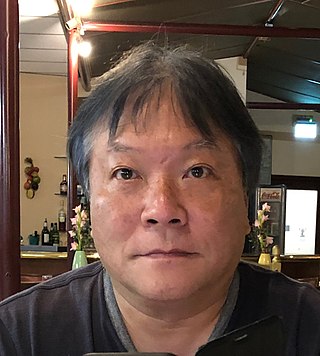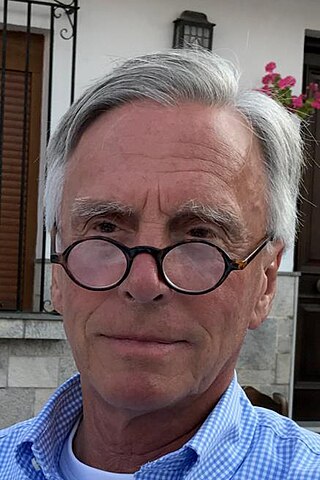
John Charles Polanyi is a German-born Canadian chemist. He was awarded the 1986 Nobel Prize in Chemistry for his research in chemical kinetics.
Supramolecular chemistry refers to the branch of chemistry concerning chemical systems composed of a discrete number of molecules. The strength of the forces responsible for spatial organization of the system range from weak intermolecular forces, electrostatic charge, or hydrogen bonding to strong covalent bonding, provided that the electronic coupling strength remains small relative to the energy parameters of the component. While traditional chemistry concentrates on the covalent bond, supramolecular chemistry examines the weaker and reversible non-covalent interactions between molecules. These forces include hydrogen bonding, metal coordination, hydrophobic forces, van der Waals forces, pi–pi interactions and electrostatic effects.

Jean-Marie Lehn is a French chemist. He received the Nobel Prize in Chemistry together with Donald Cram and Charles Pedersen in 1987 for his synthesis of cryptands. Lehn was an early innovator in the field of supramolecular chemistry, i.e., the chemistry of host–guest molecular assemblies created by intermolecular interactions, and continues to innovate in this field. As of January 2006, his group has published 790 peer-reviewed articles in chemistry literature.
The following outline is provided as an overview of and topical guide to nanotechnology:

Chad Alexander Mirkin is an American chemist. He is the George B. Rathmann professor of chemistry, professor of medicine, professor of materials science and engineering, professor of biomedical engineering, and professor of chemical and biological engineering, and director of the International Institute for Nanotechnology and Center for Nanofabrication and Molecular Self-Assembly at Northwestern University.

Takuzo Aida is a polymer chemist known for his work in the fields of supramolecular chemistry, materials chemistry and polymer chemistry. Aida, who is the Deputy Director for the RIKEN Center for Emergent Matter Science (CEMS) and a Distinguished University Professor at the University of Tokyo, has made pioneering contributions to the initiation, fundamental progress, and conceptual expansion of supramolecular polymerization. Aida has also been a leader and advocate for addressing critical environmental issues caused by plastic waste and microplastics in the oceans, soil, and food supply, through the development of dynamic, responsive, healable, reorganizable, and adaptive supramolecular polymers and related soft materials.
Jeremy Keith Morris Sanders is a British chemist and Emeritus Professor in the Department of Chemistry at the University of Cambridge. He is also Editor-in-Chief of Royal Society Open Science. He is known for his contributions to many fields including NMR spectroscopy and supramolecular chemistry. He served as the Pro-Vice-Chancellor for Institutional Affairs at the University of Cambridge, 2011–2015.
Victoria Michelle Kaspi is a Canadian astrophysicist and a professor at McGill University. Her research primarily concerns neutron stars and pulsars.

Darshan Ranganathan was an organic chemist from India who was known for her work in bio-organic chemistry, including "pioneering work in protein folding." She was also recognized for her work in "supramolecular assemblies, molecular design, chemical simulation of key biological processes, synthesis of functional hybrid peptides and synthesis of nanotubes."

Eugenia Kumacheva is a University Professor and Distinguished Professor of Chemistry at the University of Toronto. Her research interests span across the fields of fundamental and applied polymers science, nanotechnology, microfluidics, and interface chemistry. She was awarded the L'Oréal-UNESCO Awards for Women in Science in 2008 "for the design and development of new materials with many applications including targeted drug delivery for cancer treatments and materials for high density optical data storage". In 2011, she published a book on the Microfluidic Reactors for Polymer Particles co-authored with Piotr Garstecki. She is Canadian Research Chair in Advanced Polymer Materials. She is Fellow of the Royal Society (FRS) and a Fellow of the Royal Society of Canada (FRSC).

Timothy M. Swager is an American Scientist and the John D. MacArthur Professor of Chemistry at the Massachusetts Institute of Technology. His research is at the interface of chemistry and materials science, with specific interests in carbon nanomaterials, polymers, and liquid crystals. He is an elected member of the National Academy of Sciences, American Academy of Arts and Sciences, and the National Academy of Inventors.
Niveen M. Khashab is a Lebanese chemist and an associate Professor of chemical Sciences and engineering at King Abdullah University of Science and Technology in Saudi Arabia since 2009. She is a laureate of the 2017 L'Oréal-UNESCO Awards for Women in Science "for her contributions to innovative smart hybrid materials aimed at drug delivery and for developing new techniques to monitor intracellular antioxidant activity." She is also a fellow of the Royal Chemical Society, and a member of the American Chemical Society.

Santanu Bhattacharya is an Indian chemical biologist and a professor at the Indian Institute of Science. He is known for his studies of unnatural amino acids, oligopeptides, designed and natural lipids and biologically active natural products and is an elected fellow of the Indian National Science Academy The World Academy of Sciences and the Indian Academy of Sciences The Council of Scientific and Industrial Research, the apex agency of the Government of India for scientific research, awarded him the Shanti Swarup Bhatnagar Prize for Science and Technology, one of the highest Indian science awards, in 2003, for his contributions to chemical sciences. He is also a recipient of the National Bioscience Award for Career Development of the Department of Biotechnology (2002) and the TWAS Prize (2010).

Marcey Lynn Waters is the Glen H. Elder Jr., Distinguished Professor of Chemistry at the University of North Carolina, Chapel Hill (UNC-CH). She is an organic chemist whose research is at the interface of chemical biology and supramolecular chemistry. Waters has received multiple awards, for research, teaching, and advocating for women in science. She is serving the President of the American Peptide Society from 2017 to 2019.

Roeland J. M. Nolte is a Dutch chemist, known for his work in the fields of organic chemistry, biochemistry, polymer chemistry, and supramolecular chemistry. He is an emeritus Royal Netherlands of Arts and Sciences professor and an emeritus professor of Organic Chemistry at Radboud University in Nijmegen, The Netherlands. Currently, he holds a special chair, i.e. professor of Molecular Nanotechnology, at this university. Nolte is considered to be one of the pioneers of the field of supramolecular chemistry, which encompasses the design and synthesis of new chemical structures from low molecular weight compounds and biopolymers using so-called non-covalent interactions. He published many studies on supramolecular assembly and biomimetic catalysts, which find applications in the field of nanomaterials and medicine.
Katrina Anne Jolliffe is an Australian supramolecular and organic chemist and professor at the University of Sydney.
Silvia Giordani is an Italian chemist who is Professor of Nanomaterials at Dublin City University. Her research considers carbon-based functional materials for biotechnology. She was awarded a L'Oréal-UNESCO For Women in Science fellowship in 2012.

Bin Liu is a chemist who is Professor and Provost's Chair at the National University of Singapore. Her research considers polymer chemistry and organic functional materials. She was appointed Vice President of Research and Technology in 2019. She was awarded the 2021 Royal Society of Chemistry Centenary Prize.

Chunying Chen is a Chinese chemist who is a professor at the National Center for Nanoscience and Technology. Her research considers nanoscale biological interactions. She was awarded the 2021 Royal Society of Chemistry Environment, Sustainability and Energy Award. She is a Fellow of the American Institute for Medical and Biological Engineering and the Royal Society of Chemistry.
Emily D. Cranston is a Canadian chemist who is a professor at the University of British Columbia and President’s Excellence Chair in Forest Bioproducts. She investigates nanocellulose and hybrid bio-based materials. Cranston is an NSERC E.W.R. Steacie fellow and was awarded the Kavli Emerging Leader in Chemistry lectureship in 2018 and the Tappi NanoDivision Technical Award in 2021.











